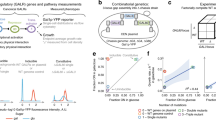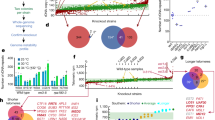Abstract
According to what we term the balance hypothesis, an imbalance in the concentration of the subcomponents of a protein–protein complex can be deleterious1. If so, there are two consequences: first, both underexpression and overexpression of protein complex subunits should lower fitness, and second, the accuracy of transcriptional co-regulation of subunits should reflect the deleterious consequences of imbalance. Here we show that all these predictions are upheld in yeast (Saccharomyces cerevisiae). This supports the hypothesis2,3 that dominance is a by-product of physiology and metabolism rather than the result of selection to mask the deleterious effects of mutations. Beyond this, single-gene duplication of protein subunits is expected to be harmful, as this, too, leads to imbalance. As then expected, we find that members of large gene families are rarely involved in complexes. The balance hypothesis therefore provides a single theoretical framework for understanding components both of dominance and of gene family size.
This is a preview of subscription content, access via your institution
Access options
Subscribe to this journal
Receive 51 print issues and online access
$199.00 per year
only $3.90 per issue
Buy this article
- Purchase on Springer Link
- Instant access to full article PDF
Prices may be subject to local taxes which are calculated during checkout


Similar content being viewed by others
References
Veitia, R. A. Exploring the etiology of haploinsufficiency. BioEssays 24, 175–184 (2002)
Wright, S. Physiological and evolutionary theories of dominance. Am. Nat. 68, 25–53 (1934)
Kacser, H. & Burns, J. A. The molecular basis of dominance. Genetics 97, 639–666 (1981)
Mewes, H. W. et al. MIPS: a database for genomes and protein sequences. Nucleic Acids Res. 30, 31–34 (2002)
Rottensteiner, H., Kal, A. J., Hamilton, B., Ruis, H. & Tabak, H. F. A heterodimer of the Zn2Cys6 transcription factors Pip2p and Oaf1p controls induction of genes encoding peroxisomal proteins in Saccharomyces cerevisiae. Eur. J. Biochem. 247, 776–783 (1997)
Wu, X., Hart, H., Cheng, C., Roach, P. J. & Tatchell, K. Characterization of Gac1p, a regulatory subunit of protein phosphatase type I involved in glycogen accumulation in Saccharomyces cerevisiae. Mol. Genet. Genomics 265, 622–635 (2001)
Abruzzi, K. C., Smith, A., Chen, W. & Solomon, F. Protection from free beta-tubulin by the beta-tubulin binding protein Rbl2p. Mol. Cell Biol. 22, 138–147 (2002)
Yuan, J. et al. The instability of the membrane skeleton in thalassemic red blood cells. Blood 86, 3945–3950 (1995)
Bray, D. & Lay, S. Computer-based analysis of the binding steps in protein complex formation. Proc. Natl Acad. Sci. USA 94, 13493–13498 (1997)
Warner, J. R. The economics of ribosome biosynthesis in yeast. Trends Biochem. Sci. 24, 437–440 (1999)
Steinmetz, L. M. et al. Systematic screen for human disease genes in yeast. Nature Genet. 31, 400–404 (2002)
van Holde, K. E., Johnson, W. C. & Shing Ho, P. Principles of Physical Biochemistry (Prentice Hall, Upper Saddle River, New Jersey, 1998)
Stevens, R. C. & Davis, T. N. Mlc1p is a light chain for the unconventional myosin Myo2p in Saccharomyces cerevisiae. J. Cell Biol. 142, 711–722 (1998)
Ge, H., Liu, Z., Church, G. M. & Vidal, M. Correlation between transcriptome and interactome mapping data from Saccharomyces cerevisiae. Nature Genet. 29, 482–486 (2001)
Giaever, G. et al. Functional profiling of the Saccharomyces cerevisiae genome. Nature 418, 387–391 (2002)
Fisher, R. A. The Genetical Theory of Natural Selection (Clarendon, Oxford, 1930)
Li, B., Vilardell, J. & Warner, J. R. An RNA structure involved in feedback regulation of splicing and of translation is critical for biological fitness. Proc. Natl Acad. Sci. USA 93, 1596–1600 (1996)
Wolfe, K. H. & Shields, D. C. Molecular evidence for an ancient duplication of the entire yeast genome. Nature 387, 708–713 (1997)
Kihm, A. J. et al. An abundant erythroid protein that stabilizes free α-haemoglobin. Nature 417, 758–763 (2002)
Hughes, T. R. et al. Functional discovery via a compendium of expression profiles. Cell 102, 109–126 (2000)
Carroll, S. B., Grenier, J. K. & Weatherbee, S. D. From DNA to Diversity (Blackwell Science, Malden, Massachusetts, 2001)
Hodgkin, J. Fluxes, doses and poisons—molecular perspectives on dominance. Trends Genet. 9, 1–2 (1993)
Kratz, E., Dugas, J. C. & Ngai, J. Odorant receptor gene regulation: Implications from genomic organization. Trends Genet. 18, 29–34 (2002)
Johnston, M. Feasting, fasting and fermenting. Glucose sensing in yeast and other cells. Trends Genet. 15, 29–33 (1999)
Hodges, P. E., McKee, A. H., Davis, B. P., Payne, W. E. & Garrels, J. I. The Yeast Proteome Database (YPD): A model for the organization and presentation of genome-wide functional data. Nucleic Acids Res. 27, 69–73 (1999)
Gavin, A. C. et al. Functional organization of the yeast proteome by systematic analysis of protein complexes. Nature 415, 141–147 (2002)
von Mering, C. et al. Comparative assessment of large-scale data sets of protein–protein interactions. Nature 417, 399–403 (2002)
Altschul, S. F. et al. Gapped BLAST and PSI-BLAST: a new generation of protein database search programs. Nucleic Acids Res. 25, 3389–3402 (1997)
Eisen, M. B., Spellman, P. T., Brown, P. O. & Botstein, D. Cluster analysis and display of genome-wide expression patterns. Proc. Natl Acad. Sci. USA 95, 14863–14868 (1998)
Sokal, R. & Rohlf, M. Biometry (Freeman, New York, 1995)
Acknowledgements
We thank C. Scharfe, L. Steinmetz, D. Bray and B. Charlesworth for comments on the manuscript. B.P. is supported by an EU Marie Curie Fellowship, C.P. by a Royal Society/Nato Fellowship and L.D.H. by the BBSRC.
Author information
Authors and Affiliations
Corresponding author
Ethics declarations
Competing interests
The authors declare that they have no competing financial interests.
Supplementary information
Rights and permissions
About this article
Cite this article
Papp, B., Pál, C. & Hurst, L. Dosage sensitivity and the evolution of gene families in yeast. Nature 424, 194–197 (2003). https://doi.org/10.1038/nature01771
Received:
Accepted:
Issue Date:
DOI: https://doi.org/10.1038/nature01771
This article is cited by
-
From beer to breadboards: yeast as a force for biological innovation
Genome Biology (2024)
-
Expectations of duplicate gene retention under the gene duplicability hypothesis
BMC Ecology and Evolution (2023)
-
Dosage balance acts as a time-dependent selective barrier to subfunctionalization
BMC Ecology and Evolution (2023)
-
Comparative gene retention analysis in barley, wild emmer, and bread wheat pangenome lines reveals factors affecting gene retention following gene duplication
BMC Biology (2023)
-
Redundancy and the role of protein copy numbers in the cell polarization machinery of budding yeast
Nature Communications (2023)
Comments
By submitting a comment you agree to abide by our Terms and Community Guidelines. If you find something abusive or that does not comply with our terms or guidelines please flag it as inappropriate.



